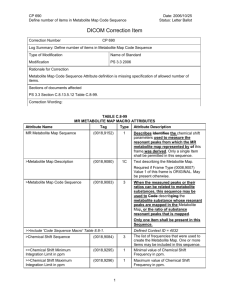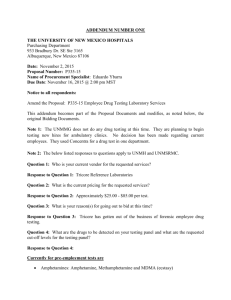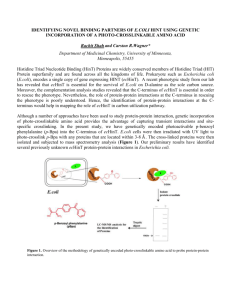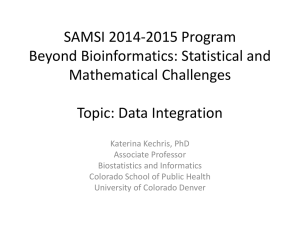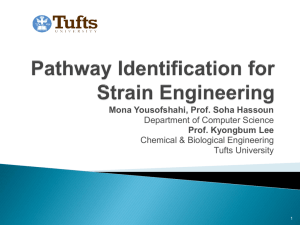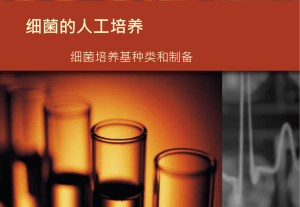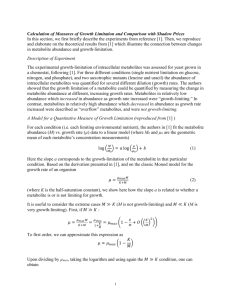Supplementary Material Article title: Numerical simulation of
advertisement
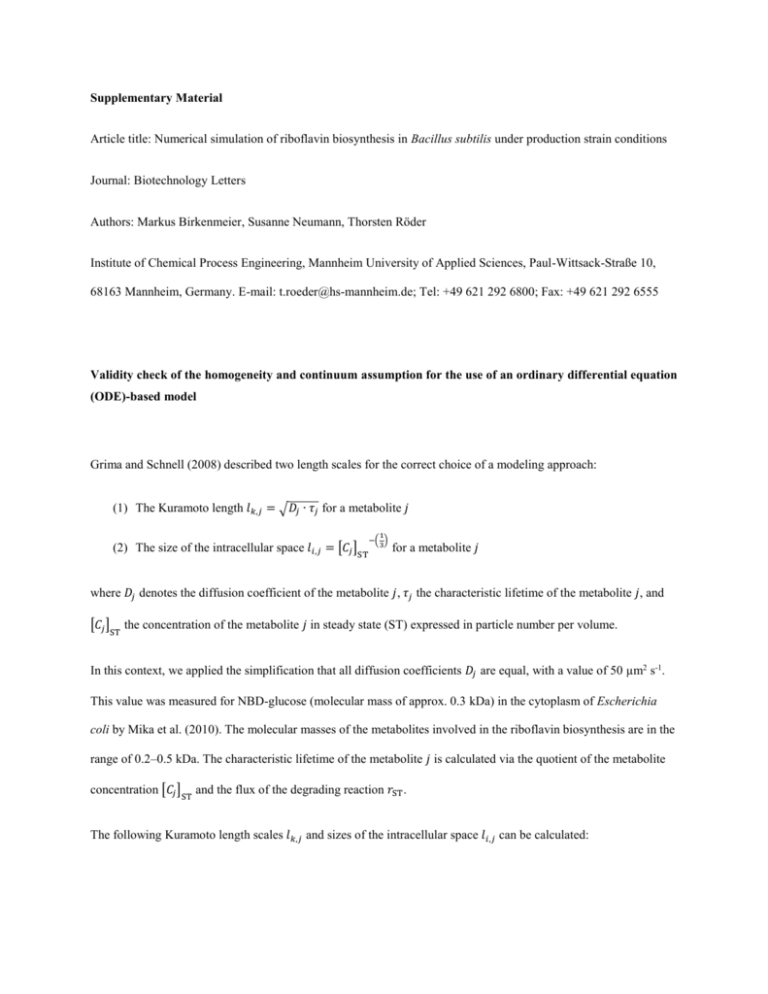
Supplementary Material Article title: Numerical simulation of riboflavin biosynthesis in Bacillus subtilis under production strain conditions Journal: Biotechnology Letters Authors: Markus Birkenmeier, Susanne Neumann, Thorsten Röder Institute of Chemical Process Engineering, Mannheim University of Applied Sciences, Paul-Wittsack-Straße 10, 68163 Mannheim, Germany. E-mail: t.roeder@hs-mannheim.de; Tel: +49 621 292 6800; Fax: +49 621 292 6555 Validity check of the homogeneity and continuum assumption for the use of an ordinary differential equation (ODE)-based model Grima and Schnell (2008) described two length scales for the correct choice of a modeling approach: (1) The Kuramoto length 𝑙𝑘,𝑗 = √𝐷𝑗 ∙ 𝜏𝑗 for a metabolite 𝑗 (2) The size of the intracellular space 𝑙𝑖,𝑗 = [𝐶𝑗 ]ST 1 3 −( ) for a metabolite 𝑗 where 𝐷𝑗 denotes the diffusion coefficient of the metabolite 𝑗, 𝜏𝑗 the characteristic lifetime of the metabolite 𝑗, and [𝐶𝑗 ]ST the concentration of the metabolite 𝑗 in steady state (ST) expressed in particle number per volume. In this context, we applied the simplification that all diffusion coefficients 𝐷𝑗 are equal, with a value of 50 µm2 s-1. This value was measured for NBD-glucose (molecular mass of approx. 0.3 kDa) in the cytoplasm of Escherichia coli by Mika et al. (2010). The molecular masses of the metabolites involved in the riboflavin biosynthesis are in the range of 0.2–0.5 kDa. The characteristic lifetime of the metabolite 𝑗 is calculated via the quotient of the metabolite concentration [𝐶𝑗 ]ST and the flux of the degrading reaction 𝑟ST . The following Kuramoto length scales 𝑙𝑘,𝑗 and sizes of the intracellular space 𝑙𝑖,𝑗 can be calculated: No. j 1 2 3 4 5 6 7 8 9 Metabolite A B C D E F G H R [Cj]ST Number of rST τj lk,j li,j (mM) molecules per cell (-) (mM/s) (s) (µm) (µm) 0.532 0.008 0.057 2.579E-06 0.113 1.221 0.357 0.002 5.833E-04 320370 4697 34205 2 68109 735166 215046 964 351 0.0035 0.0035 0.0035 0.0035 0.0070 0.0070 0.0070 0.0035 0.0035 152.00 2.23 16.23 7.37E-04 16.16 174.40 51.01 0.46 0.17 87.18 10.56 28.49 0.19 28.42 93.38 50.50 4.78 2.89 0.015 0.060 0.031 0.864 0.024 0.011 0.017 0.101 0.142 The criteria for the use of an ODE-based model are: (1) Homogeneity assumption: 𝑙𝑘,𝑗 ≫ 𝐿 (2) Continuum assumption: 𝑙𝑖,𝑗 ≪ 𝐿 where 𝐿 is the characteristic length of the system under consideration. In our case, we chose the characteristic length 𝐿 of 1 µm for a typical bacterial cell. Therefore, all metabolites except D fulfill the above noted criteria. The metabolite D does not fulfill the criteria because of the fast hypothetical kinetic parameters of the phosphatase reaction (kcat of 20 s-1, reaction 4) compared with the other reactions (see Table 1). Thus, metabolite D is quickly degraded in the system and the stationary concentration is relatively low. This result is virtual because of our assumption and is not crucial for the simulation. Scaling factor for the adaptation of the kinetic parameters of the deaminase and reductase reactions from Escherichia coli to Bacillus subtilis The following kinetic parameters of the deaminase and reductase activities for the bifunctional Enzyme RibD of E. coli are listed in Magalhães et al. (2008): 𝑘𝑐𝑎𝑡,𝑑𝑒𝑎𝑚𝑖𝑛𝑎𝑠𝑒,𝐵 = 370 1 1 = 6.17 min s 𝐾𝑚,𝐵 = 1.3 mM 𝑘𝑐𝑎𝑡,𝑟𝑒𝑑𝑢𝑐𝑡𝑎𝑠𝑒,𝐶 = 19 1 1 = 0.317 min s 𝑘𝑐𝑎𝑡,𝑟𝑒𝑑𝑢𝑐𝑡𝑎𝑠𝑒,𝑁𝐴𝐷𝑃𝐻 = 18.5 1 1 = 0.308 min s 𝐾𝑚,𝐶 = 0.037 mM Richter et al. (1997) measured the specific activities 𝑣 of the bifunctional enzymes RibG for B. subtilis and RibD for E. coli: 𝑣𝑅𝑖𝑏𝐺,𝑑𝑒𝑎𝑚𝑖𝑛𝑎𝑠𝑒,𝐵 = 9.9 µmol mg h 𝑣𝑅𝑖𝑏𝐺,𝑟𝑒𝑑𝑢𝑐𝑡𝑎𝑠𝑒,𝑁𝐴𝐷𝑃𝐻 = 0.6 𝑣𝑅𝑖𝑏𝐷,𝑑𝑒𝑎𝑚𝑖𝑛𝑎𝑠𝑒,𝐵 = 21.3 µmol mg h µmol mg h 𝑣𝑅𝑖𝑏𝐷,𝑟𝑒𝑑𝑢𝑐𝑡𝑎𝑠𝑒,𝑁𝐴𝐷𝑃𝐻 = 6.7 µmol mg h In this study, we used the specific activities 𝑣 of Richter et al. (1997) to calculate scaling factors to adapt the turnover numbers 𝑘𝑐𝑎𝑡 from RibD from Magalhães et al. (2008) to RibG in our model (see Table 1): 𝑘𝑐𝑎𝑡,2 𝑘𝑐𝑎𝑡,3 µmol 9.9 𝑣𝑅𝑖𝑏𝐺,𝑑𝑒𝑎𝑚𝑖𝑛𝑎𝑠𝑒,𝐵 1 min 1 mg h = 𝑘𝑐𝑎𝑡,𝑑𝑒𝑎𝑚𝑖𝑛𝑎𝑠𝑒,𝐵 ∙ ( ) = 370 ∙ ∙( ) = 2.87 𝑣𝑅𝑖𝑏𝐷,𝑑𝑒𝑎𝑚𝑖𝑛𝑎𝑠𝑒,𝐵 min 60 s 21.3 µmol s mg h µmol 𝑣𝑅𝑖𝑏𝐺,𝑟𝑒𝑑𝑢𝑐𝑡𝑎𝑠𝑒,𝑁𝐴𝐷𝑃𝐻 1 min 0.6 mg h 1 = 𝑘𝑐𝑎𝑡,𝑟𝑒𝑑𝑢𝑐𝑡𝑎𝑠𝑒,𝐶 ∙ ( ) = 19 ∙ ∙( ) = 0.0284 µmol 𝑣𝑅𝑖𝑏𝐷,𝑟𝑒𝑑𝑢𝑐𝑡𝑎𝑠𝑒,𝑁𝐴𝐷𝑃𝐻 min 60 s 6.7 s mg h We used this procedure to account for the smaller activities of RibG compared with RibD. We used the MichaelisMenten constants from RibD in our simulation because no RibG constants were available in the literature. Full expression of the objective function for the minimization of the enzyme concentrations (Eq. (2)) 𝑟3 = [𝐸𝑅𝑖𝑏𝐺 ] ∙ 𝑘𝑐𝑎𝑡,3 ∙ [𝐶] 𝐾𝑚,𝐶 + [𝐶] 𝑟6 = [𝐸𝑅𝑖𝑏𝐻 ] ∙ 𝑘𝑐𝑎𝑡,6 ∙ [𝐸] ∙ [𝐺] 𝐾𝑚,𝐸 ∙ 𝐾𝑚,𝐺 + 𝐾𝑚,𝐺 ∙ [𝐸] + 𝐾𝑚,𝐸 ∙ [𝐺] + [𝐸] ∙ [𝐺] 𝑟7 = [𝐸𝑅𝑖𝑏𝐵 ] ∙ 𝑘𝑐𝑎𝑡,7 ∙ [𝐻] 𝐾𝑚,𝐻 + [𝐻] Therefore, steady state Eq. (2) can be expressed in the following form: min [𝐸𝑡𝑜𝑡 ] = [𝐸𝑅𝑖𝑏𝐺 ] + [𝐸𝑅𝑖𝑏𝐻 ] + [𝐸𝑅𝑖𝑏𝐵 ] = 𝐽3 𝐽6 𝐽7 + + 𝑘𝑐𝑎𝑡,3 ∙ [𝐶] 𝑘𝑐𝑎𝑡,6 ∙ [𝐸] ∙ [𝐺] 𝑘𝑐𝑎𝑡,7 ∙ [𝐻] 𝐾𝑚,𝐶 + [𝐶] 𝐾𝑚,𝐸 ∙ 𝐾𝑚,𝐺 + 𝐾𝑚,𝐺 ∙ [𝐸] + 𝐾𝑚,𝐸 ∙ [𝐺] + [𝐸] ∙ [𝐺] 𝐾𝑚,𝐻 + [𝐻] Analytical expressions for the calculation of the scaled elasticities In General: irreversible Michaelis-Menten rate law 𝑟= [𝐸𝑛𝑧𝑦𝑚] ∙ 𝑘𝑐𝑎𝑡 ∙ [𝑆] 𝐾𝑚 + [𝑆] 𝑟 𝑒[𝑆] = 𝜕𝑟 [𝑆] ∙ = 𝜕[𝑆] 𝑟 1 [𝑆] 1+ 𝐾𝑚 Reaction 6: irreversible random bi-uni rate law (Liebermeister and Klipp 2006) 𝑟6 = [𝐸𝑅𝑖𝑏𝐻 ] ∙ 𝑘𝑐𝑎𝑡,6 ∙ [𝐸] ∙ [𝐺] 𝐾𝑚,𝐸 ∙ 𝐾𝑚,𝐺 + 𝐾𝑚,𝐺 ∙ [𝐸] + 𝐾𝑚,𝐸 ∙ [𝐺] + [𝐸] ∙ [𝐺] 𝑟6 𝑒[𝐸] 𝜕𝑟6 [𝐸] = ∙ = 𝜕[𝐸] 𝑟6 [𝐺] 𝐾𝑚,𝐺 [𝐸] [𝐺] [𝐸] [𝐺] 1+ + + ∙ 𝐾𝑚,𝐸 𝐾𝑚,𝐺 𝐾𝑚,𝐸 𝐾𝑚,𝐺 𝑟6 𝑒[𝐺] 𝜕𝑟6 [𝐺] = ∙ = 𝜕[𝐺] 𝑟6 [𝐸] 𝐾𝑚,𝐸 [𝐸] [𝐺] [𝐸] [𝐺] 1+ + + ∙ 𝐾𝑚,𝐸 𝐾𝑚,𝐺 𝐾𝑚,𝐸 𝐾𝑚,𝐺 1+ 1+ References – Supplementary Material Grima R, Schnell S (2008) Modelling reaction kinetics inside cells. Essays Biochem 45:41-56 Liebermeister W, Klipp E (2006) Bringing metabolic networks to life: convenience rate law and thermodynamic constraints. Theor Biol Med Model 3:41. doi: 10.1186/1742-4682-3-41 Mika JT, van den Bogaart G, Veenhoff L, Krasnikov V, Poolman B (2010) Molecular sieving properties of the cytoplasm of Escherichia coli and consequences of osmotic stress. Mol Microbiol 77:200-207 Magalhães ML, Argyrou A, Cahill SM, Blanchard JS (2008) Kinetic and mechanistic analysis of the Escherichia coli ribD-encoded bifunctional deaminase-reductase involved in riboflavin biosynthesis. Biochemistry 47:6499:6507 Richter G, Fischer M, Krieger C, Eberhardt S, Lüttgen H, Gerstenschläger I, Bacher A (1997) Biosynthesis of riboflavin: characterization of the bifunctional deaminase-reductase of Escherichia coli and Bacillus subtilis. J Bacteriol 179:2002-2028
